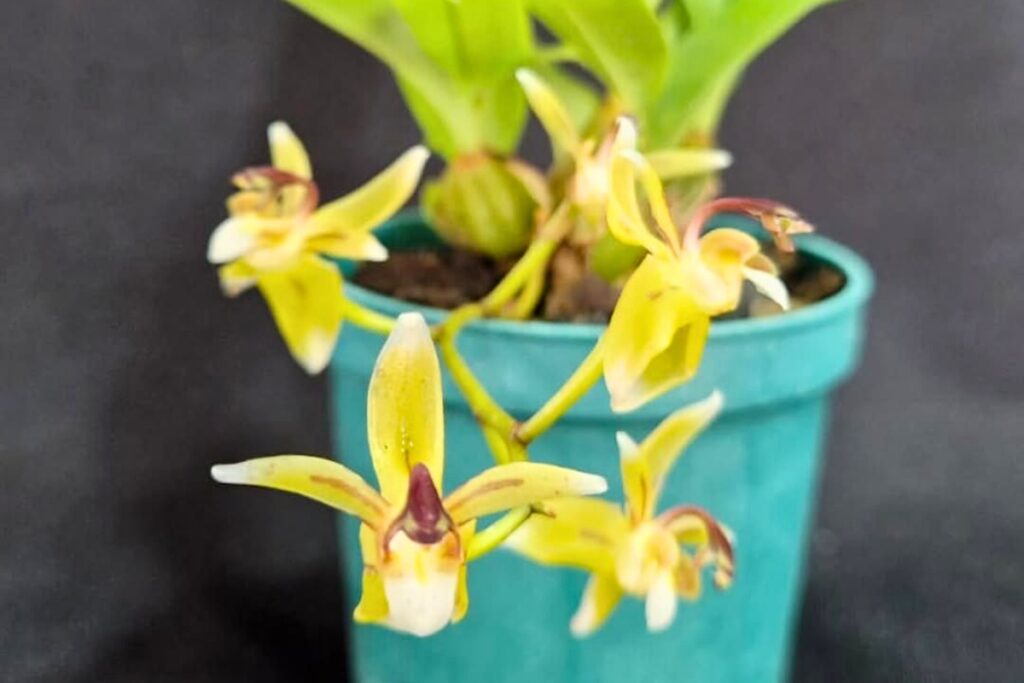Did you know that Cattleya orchids can bloom for up to 75 years when properly maintained? You’ll find these stunning flowers, often called the “Queen of Orchids,” to be surprisingly manageable with the right approach. While they’ve earned a reputation for being finicky, you don’t need a professional greenhouse to keep them thriving. The secret lies in understanding five key care elements that’ll transform your orchid from a short-term guest into a lifelong companion.

Contents
Essential Growing Conditions for Healthy Cattleyas
While Cattleya orchids can adapt to various environments, they thrive best under specific conditions that mirror their natural habitat. You’ll need bright, indirect sunlight for 5-6 hours daily, maintaining temperatures between 65-80°F during the day and 55-65°F at night.
Keep humidity levels at 50-70% using a humidity tray or small humidifier. Your orchids will flourish in well-draining potting media, such as bark mix or sphagnum moss. Place them in a spot with good air circulation, but avoid cold drafts from windows or vents.
Water thoroughly when the growing medium feels dry about 1 inch below the surface, typically every 7-10 days.
Proper Watering and Fertilization Techniques

Because Cattleya orchids are sensitive to both overwatering and underwatering, you’ll need to master a careful balance in your watering routine. Water thoroughly when the potting medium feels dry about 1 inch below the surface, typically every 5-7 days during growing season and 10-14 days during rest periods.
For fertilization, follow the “weekly, weakly” rule: apply a balanced 20-20-20 orchid fertilizer at quarter strength once a week during active growth. During the blooming phase, switch to a high-phosphorus formula (10-30-20) at the same dilution rate, and reduce feeding to monthly intervals during winter dormancy.
Mastering Light and Temperature Requirements
Since Cattleya orchids naturally grow in tree canopies, they’ll need bright, indirect sunlight for 5-6 hours daily to thrive. Place them near an east or south-facing window, using sheer curtains to filter intense afternoon rays.
Maintain temperatures between 65-80°F (18-27°C) during the day and 55-65°F (13-18°C) at night. Your orchids will appreciate a 10-15°F drop in temperature when darkness falls, as this mimics their natural habitat conditions.
If you’re growing under artificial lights, position LED or fluorescent bulbs 6-12 inches above the plants. Watch for leaf color – bright green indicates proper light, while dark green suggests insufficient exposure, and reddish leaves signal too much light.
Repotting and Root Care Guidelines
Just as Cattleya orchids need proper light conditions to flourish, they require strategic repotting to maintain healthy root systems. Plan to repot your orchid every 2-3 years, or when you notice the potting medium breaking down or roots spilling over the pot’s edge.
Choose a pot that’s 1-2 inches larger than the current one, with plenty of drainage holes. You’ll want to use a coarse orchid mix containing fir bark, charcoal, and perlite. Gently remove the old medium, trim any dead roots (they’ll appear brown and mushy), and position the plant so the rhizome sits just below the medium’s surface.
Common Problems and Prevention Strategies
While Cattleya orchids are generally hardy plants, they can face several common challenges that’ll test even experienced growers. Root rot, bud blast, and mealybugs are frequent issues you’ll need to watch for.
Check your plant’s roots weekly for signs of rot – they should be firm and light green or white, not brown and mushy. If you spot rot, trim affected areas with sterilized scissors and reduce watering frequency by 30%.
To prevent bud blast, maintain temperatures between 65-80°F and protect blooms from drafts. For mealybugs, wipe leaves with 70% isopropyl alcohol using a cotton swab, repeating treatment every five days until resolved.
